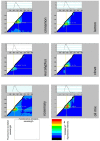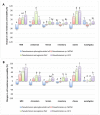Multidisciplinary Studies of Folk Medicine "Five Thieves' Oil" (Olejek Pięciu Złodziei) Components
- PMID: 34069178
- PMCID: PMC8155914
- DOI: 10.3390/molecules26102931
Multidisciplinary Studies of Folk Medicine "Five Thieves' Oil" (Olejek Pięciu Złodziei) Components
Abstract
To meet the growing interest in natural antibacterial agents, we evaluated the physicochemical and biological properties of the folk medicine known as "five thieves' oil" (Polish name: olejek pięciu złodziei). Five thieves' oil consists of a mixture of five oils: rosemary, lemon, clove, eucalyptus, and cinnamon. In this study, we performed gas chromatography, FTIR, and UV-vis spectroscopic analysis, as well as L-a-b color tests, contact angle determination, and surface tension determination. To verify its antibacterial activity, the metabolic activity and changes in cell membrane permeability of bacteria of the genus Pseudomonas were studied. As a result, it was found that among the constituent oils, the oils of clove and cinnamon were the least volatile and, at the same time, had the strongest antibacterial activity. However, a mix of all the oils also showed comparable activity, which was even more pronounced for the oils after 4 weeks of aging. This effect can be linked to the high content of terpene derivatives such as eugenol and cinnamaldehyde, which can cause changes in bacterial membrane permeability, affecting cell activity and survival. This study is the first to characterize the constituents of the popular folk medicine five thieves' oil, confirming and explaining its strong antibacterial activity, thus constituting a significant contribution to contemporary health education.
Keywords: Pseudomonas; antibacterial activity; essential oils; health education; spectrometry; terpenes.
Conflict of interest statement
The authors declare no conflict of interest.
Figures









Similar articles
-
Microscopic Droplet Size Analysis (MDSA) of "Five Thieves' Oil" (Olejek Pięciu Złodziei) Essential Oil after the Nebulization Process.Molecules. 2023 May 26;28(11):4368. doi: 10.3390/molecules28114368. Molecules. 2023. PMID: 37298844 Free PMC article.
-
Chemical composition and antibacterial activity of essential oils against pathogens often related to cattle endometritis.J Infect Dev Ctries. 2020 Feb 29;14(2):177-183. doi: 10.3855/jidc.12076. J Infect Dev Ctries. 2020. PMID: 32146452
-
Identification of essential oils with activity against stationary phase Staphylococcus aureus.BMC Complement Med Ther. 2020 Mar 24;20(1):99. doi: 10.1186/s12906-020-02898-4. BMC Complement Med Ther. 2020. PMID: 32209108 Free PMC article.
-
Essential Oils as Antimicrobial Agents-Myth or Real Alternative?Molecules. 2019 Jun 5;24(11):2130. doi: 10.3390/molecules24112130. Molecules. 2019. PMID: 31195752 Free PMC article. Review.
-
A comprehensive review of the antibacterial, antifungal and antiviral potential of essential oils and their chemical constituents against drug-resistant microbial pathogens.Microb Pathog. 2019 Sep;134:103580. doi: 10.1016/j.micpath.2019.103580. Epub 2019 Jun 11. Microb Pathog. 2019. PMID: 31195112 Review.
Cited by
-
Using Rosemary Essential Oil as a Potential Natural Preservative during Stirred-like Yogurt Making.Foods. 2022 Jul 6;11(14):1993. doi: 10.3390/foods11141993. Foods. 2022. PMID: 35885236 Free PMC article.
-
Microscopic Droplet Size Analysis (MDSA) of "Five Thieves' Oil" (Olejek Pięciu Złodziei) Essential Oil after the Nebulization Process.Molecules. 2023 May 26;28(11):4368. doi: 10.3390/molecules28114368. Molecules. 2023. PMID: 37298844 Free PMC article.
-
Effect of Rosemary (Rosmarinus officinalis L.) Supplementation on Probiotic Yoghurt: Physicochemical Properties, Microbial Content, and Sensory Attributes.Foods. 2021 Oct 9;10(10):2393. doi: 10.3390/foods10102393. Foods. 2021. PMID: 34681443 Free PMC article.
-
The Selection of the Optimal Impregnation Conditions of Vegetable Matrices with Iodine.Molecules. 2022 May 23;27(10):3351. doi: 10.3390/molecules27103351. Molecules. 2022. PMID: 35630828 Free PMC article.
-
Eco-Friendly Solution Based on Rosmarinus officinalis Hydro-Alcoholic Extract to Prevent Biodeterioration of Cultural Heritage Objects and Buildings.Int J Mol Sci. 2022 Sep 28;23(19):11463. doi: 10.3390/ijms231911463. Int J Mol Sci. 2022. PMID: 36232763 Free PMC article.
References
-
- Macwan S.R., Dabhi B.K., Aparnathi K.D., Prajapati J.B. Essential Oils of Herbs and Spices: Their Antimicrobial Activity and Application in Preservation of Food. Int. J. Curr. Microbiol. Appl. Sci. 2016;5:885–901. doi: 10.20546/ijcmas.2016.505.092. - DOI
-
- Blackaby A. The Hurst. [(accessed on 30 March 2021)]; Available online: http://www.hurstgreenhtc.org/wp-content/uploads/2020/12/The-Hurst-11lowr....
-
- Kitts D.D., Singh A., Fathordoobady F., Doi B., Pratap Singh A. Plant Extracts Inhibit the Formation of Hydroperoxides and Help Maintain Vitamin E Levels and Omega-3 Fatty Acids During High Temperature Processing and Storage of Hempseed and Soybean Oils. J. Food Sci. 2019;84:3147–3155. doi: 10.1111/1750-3841.14817. - DOI - PubMed
MeSH terms
Substances
LinkOut - more resources
Full Text Sources
Research Materials
Miscellaneous

